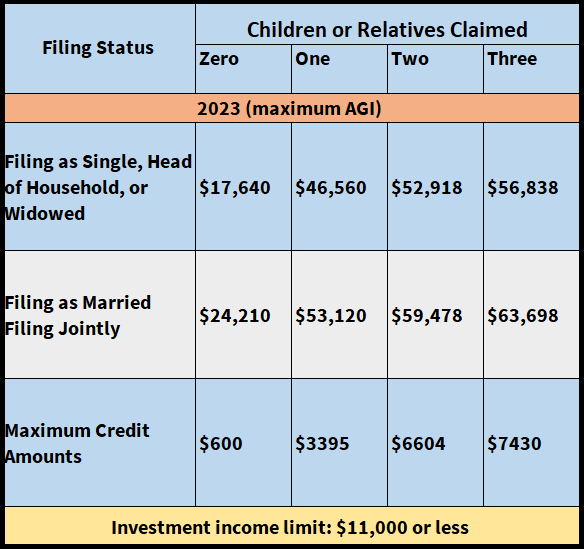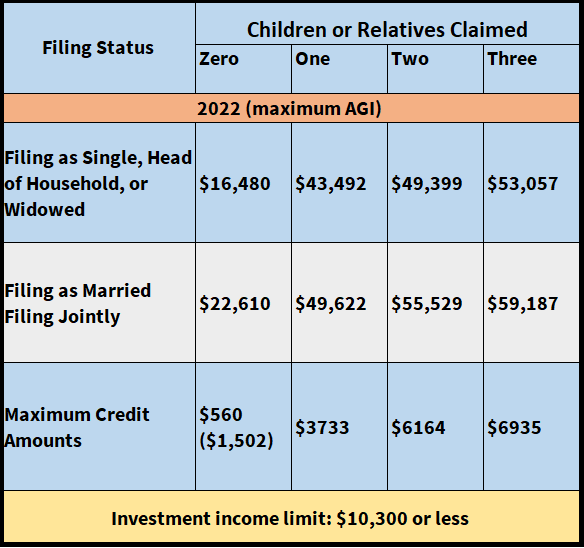Introduction:
The Earned Income Tax Credit (EITC) is a tax credit available to low- and moderate-income taxpayers in the United States. It is designed to provide relief for working individuals and families who earn low wages and may have difficulty making ends meet. The credit can provide a substantial boost to a taxpayer’s income, and it has been shown to be an effective anti-poverty measure. In this blog post, we will provide a detailed explanation of the EITC, its importance, and how it works.

Importance of the EITC for low- and moderate-income taxpayers:
The EITC is especially important for low- and moderate-income taxpayers because it can help them keep more of their hard-earned money. For many families, the credit can mean the difference between living in poverty and being able to pay for basic necessities like housing, food, and healthcare. Additionally, the EITC is refundable, which means that if the credit exceeds the amount of tax owed, the taxpayer will receive a refund for the difference. This can be a significant financial boost for struggling families.
Overview of what the blog post will cover:
In this blog post, we will cover the following topics related to the EITC:
- Eligibility requirements for the EITC, including income limits, filing status, and dependent status.
How to calculate the EITC and examples of how the credit works.
Changes to the EITC in recent years, including updates to income thresholds and additional benefits for families with children.
Common misconceptions and mistakes to avoid when claiming the Earned Income Tax Credit.
How to claim the EITC on your tax return and where to get additional help and resources. - By the end of this blog post, readers will have a comprehensive understanding of the EITC, its benefits, and how to claim it on their tax return.
II. Eligibility Requirements for the Earned Income Tax Credit
The Earned Income Tax Credit (EITC) is a tax credit designed to help low- and moderate-income working individuals and families. However, not everyone is eligible to receive the credit. There are specific requirements that must be met in order to qualify.
Basis Requirements
Your statement accurately summarizes the basic qualifying rules for the Earned Income Tax Credit (EITC) for tax year 2022. Here’s a bit more detail about each rule:
- Earned income: You must have worked and earned income during the tax year. The income must come from wages, salaries, tips, or self-employment income. Investment income, such as interest and dividends, does not count towards the earned income requirement.
- Income limit: Your earned income and adjusted gross income (AGI) must be below certain limits to qualify for the EITC. For tax year 2022, the maximum AGI to qualify for the EITC ranges has been given in the charts below.
- Investment income limit: Your investment income must be below $10,300 in tax year 2022 and $11,000 for 2023. Investment income includes things like interest, dividends, and capital gains.
- Social Security number: You, your spouse (if filing jointly), and any qualifying children must all have valid Social Security numbers by the due date of your tax return (including extensions).
- U.S. citizenship or residency: You must be a U.S. citizen or resident alien for the entire tax year.
- Foreign earned income: You cannot file Form 2555, which is used to claim the foreign earned income exclusion. If you have foreign earned income, you may still be eligible for the EITC, but you must meet certain rules and calculations.
- Separated spouses: If you are married but not filing a joint tax return, you must meet certain rules to qualify for the EITC. Generally, you must have a qualifying child living with you for more than half the year, and you must file as either head of household or as married filing separately.
Qualifying Child
Your statement accurately summarizes the requirements for a child to be considered a qualifying child for the Earned Income Tax Credit (EITC). Here’s a bit more detail about each requirement:
- Social Security Number: The child must have a valid Social Security Number (SSN) by the due date of your tax return (including extensions). This requirement ensures that the child is a U.S. citizen or resident alien.
- Relationship: The child must be your son, daughter, stepchild, foster child, sibling, step-sibling, half-sibling, or a descendant of any of these.
- Residency: The child must have lived with you in the United States for more than half of the tax year. Temporary absences, such as for school or medical treatment, count as time lived with you.
- Age: The child must be younger than you and either under age 19 at the end of the tax year or a full-time student under age 24 at the end of the tax year. There is no age limit if the child is permanently and totally disabled.
- Support: The child must not have provided more than half of their own support during the tax year.
- In addition, the child cannot be claimed by more than one person as a qualifying child for the EITC. If multiple taxpayers try to claim the same child, the IRS will use tiebreaker rules to determine who gets to claim the child.
Eligibility requirements for the Earned Income Tax Credit (EITC) for Tax Years 2022 and 2023:
Tax Year 2023
Income Limits for Eligibility
Children or Relatives Claimed
Zero: $17,640 for single, head of household, or widowed filers; $24,210 for married filing jointly
One: $46,560 for single, head of household, or widowed filers; $53,120 for married filing jointly
Two: $52,918 for single, head of household, or widowed filers; $59,478 for married filing jointly
Three or more: $56,838 for single, head of household, or widowed filers; $63,698 for married filing jointly
Investment Income Limit
$11,000 or less

Maximum Credit Amounts
No qualifying children: $600
1 qualifying child: $3,995
2 qualifying children: $6,604
3 or more qualifying children: $7,430
Criteria for Qualifying Children
Must be related to the taxpayer, either by birth, adoption, or marriage, and meet certain age, residency, and relationship requirements.
Age Requirements for Eligibility
Taxpayer age Maximum 64 Years, but the qualifying child must be under age 19, or under age 24 if a full-time student, or any age if permanently and totally disabled.
Tax Year 2022
Income Limits for Eligibility
Children or Relatives Claimed
Zero: $16,480 for single, head of household, or widowed filers; $22,610 for married filing jointly
One: $43,492 for single, head of household, or widowed filers; $49,622 for married filing jointly
Two: $49,399 for single, head of household, or widowed filers; $55,529 for married filing jointly
Three or more: $53,057 for single, head of household, or widowed filers; $59,187 for married filing jointly
Investment Income Limit
$10,300 or less

Maximum Credit Amounts
No qualifying children: $560($1502 as PER BBBA)
1 qualifying child: $3,733
2 qualifying children: $6,164
3 or more qualifying children: $6,935
Criteria for Qualifying Children
Must be related to the taxpayer, either by birth, adoption, or marriage, and meet certain age, residency, and relationship requirements.
Age Requirements for Eligibility
There is no age requirement for the taxpayer as per BBBA, but the qualifying child must be under age 19, or under age 24 if a full-time student, or any age if permanently and totally disabled.
III. How to Claim the Earned Income Tax Credit (EITC)
Once you’ve determined that you are eligible for the Earned Income Tax Credit (EITC), you’ll need to know how to claim it on your tax return. Here’s an overview of the steps you need to take:
Determine the correct tax year: Make sure that you are filing for the correct tax year in which you are eligible for the EITC. If you are unsure which year’s tax return you are filing, you can refer to your W-2 or 1099 form.
Gather your income documents: You’ll need to have all your income documents together, including your W-2, 1099 forms, and any other relevant tax documents.
Fill out the tax return: You can claim the Earned Income Tax Credit on your tax return by filling out either Form 1040 or Form 1040-SR. These forms will guide you through the process of claiming the credit.
Determine the amount of your EITC: The amount of your Earned Income Tax Credit depends on your income, filing status, and the number of qualifying children you have. You can use the EITC Assistant, which is a tool provided by the IRS, to calculate your Earned Income Tax Credit amount.
File your tax return: Once you have filled out your tax return, you can submit it to the IRS. You can either file electronically or mail a paper copy of your tax return to the IRS.
Check the status of your refund: If you are due a refund, you can check the status of your refund using the “Where’s My Refund” tool on the IRS website or by calling the IRS.
If you’re not comfortable filling out your tax return yourself, you can use tax software or work with a tax professional to help you claim the EITC. Many tax software programs, such as TurboTax and H&R Block, can guide you through the process of claiming the credit. Tax professionals, such as certified public accountants (CPAs) and enrolled agents, can also help you file your tax return and claim the EITC.
IV. Benefits of the EITC
The Earned Income Tax Credit (EITC) is a tax credit designed to help low- and moderate-income taxpayers reduce their tax burden and increase their take-home pay. The Earned Income Tax Credit can be a significant financial boost for eligible taxpayers, and can even help lift families out of poverty.
One of the key benefits of the Earned Income Tax Credit is that it provides a significant boost to a taxpayer’s income. Depending on income and family size, the credit can be worth up to several thousand dollars, which can make a significant difference in a family’s budget. In fact, the Earned Income Tax Credit is one of the largest anti-poverty programs in the United States, and is credited with lifting millions of families out of poverty each year.
In addition to providing a financial boost, the EITC can also help reduce income inequality. By providing a tax credit to lower-income workers, the EITC can help level the playing field for individuals and families who may be struggling to make ends meet. This can help create more economic opportunity and mobility, and ensure that everyone has a fair shot at achieving financial security.
Overall, the Earned Income Tax Credit is an important tool for helping low- and moderate-income taxpayers achieve greater financial stability and security. By providing a significant boost to income and reducing tax burden, the EITC can make a real difference in the lives of millions of Americans.
V. Other Tax Credits and Programs for Low-Income Taxpayers
In addition to the EITC, there are other tax credits and programs that can provide support for low-income taxpayers. For example, the Child Tax Credit (CTC) is a credit that can reduce a taxpayer’s federal income tax liability by up to $2,000 per qualifying child. The CTC is available to taxpayers with income up to a certain limit, and the credit is refundable up to $1,400 per child. This means that even if a taxpayer does not owe any federal income tax, they may still be able to receive a refund based on the CTC.
Another program that can provide support for low-income families is the Supplemental Nutrition Assistance Program (SNAP), formerly known as food stamps. SNAP provides assistance to eligible individuals and families to purchase food at participating retailers. The program’s benefits are based on household size, income, and expenses.
VI. EITC without child
Your statement accurately summarizes the rules for claiming the Earned Income Tax Credit (EITC) without a qualifying child. Here’s a bit more detail about each requirement:
- EITC basic qualifying rules: You must meet the basic qualifying rules for the EITC, including having earned income and meeting income limits.
- Main home in the United States: You (and your spouse, if filing jointly) must have your main home in the United States for more than half the tax year. This means that you must have a place where you regularly live and sleep in the U.S. for more than half of the year.
- Not claimed as a qualifying child: You cannot be claimed as a qualifying child on anyone else’s tax return. This means that you cannot be claimed as a dependent by someone else, such as a parent or grandparent.
- Age: You (or your spouse, if filing jointly) must be between the ages of 25 and 65 at the end of the tax year. If you are married and filing jointly, only one spouse needs to meet the age requirement.
Note that the amount of the EITC without a qualifying child is generally lower than the amount with a qualifying child. The exact amount of the credit will depend on your income, filing status, and number of qualifying children (if any).
VII. Conclusion
The Earned Income Tax Credit (EITC) is a critical program that provides support to low- and moderate-income taxpayers. By offering a credit that can boost a taxpayer’s income and help lift families out of poverty, the EITC plays an important role in reducing income inequality. Eligible taxpayers should be aware of the program’s eligibility requirements and how to claim the credit. Additionally, policymakers should continue to support the EITC and other programs that benefit low-income individuals and families. By working together, we can help create a more equitable society that provides opportunities for all.
